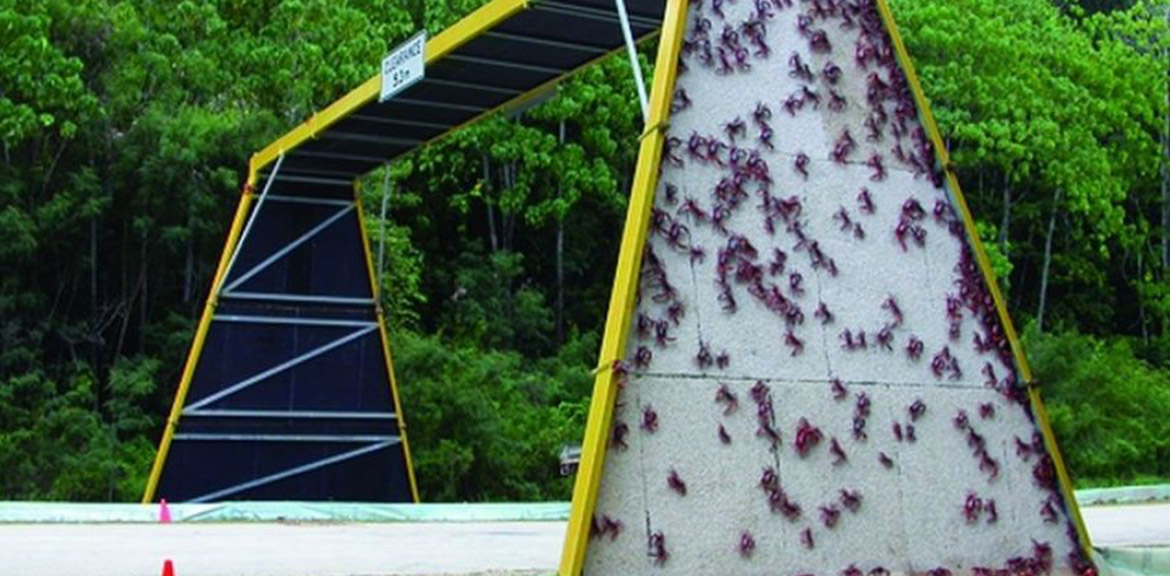Animals Crossing
Eco-Link@BKE: Safe passage for creatures over busy highwayWhere pangolins and palm civets cross the road
The Sunda pangolin’s totter is slightly absurd. With its foreclaws hanging just off the ground, it looks like a miniature T-rex as it ambles along on its hind legs.
The scaly mammal’s formidable foreclaws are built not for walking, but to rip open ant hills and termite nests.
When in danger, it may curl into a ball, relying on its armour of scales to protect its conical head and delicate underbelly.
But that armour is no protection against cars travelling at high speed.
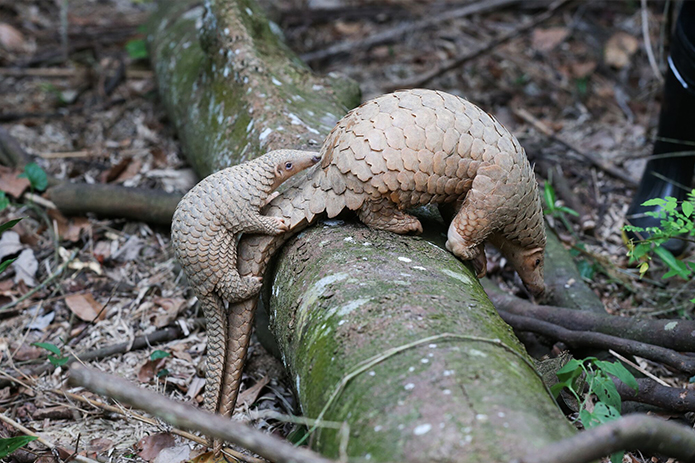
Hunched close to the ground, the pangolin is hard for any driver to spot on the road. If it is caught in the headlights of a vehicle, the shy creature may freeze; and even when fleeing, it can only rev up to a man’s jogging pace.
An average of two a year have been found dead on major roads around the Bukit Timah and Central Catchment nature reserves from 1994 to 2014, the National Parks’ Board (NParks) said. That may not seem a lot – until one realises that the total number of wild Sunda pangolins in Singapore may be just more than 50.
Classified as critically endangered on the International Union for Conservation of Nature (IUCN) Red List, it is said to be the most trafficked mammal in the world.
No dead pangolins, however, have been found on major roads near the reserves from April 2014 to October 2015.
NParks believes that instead of trying to cross the highways, they have found a passage of their own: Pangolins have been using the Eco-Link@BKE to travel between the Bukit Timah Nature Reserve and Central Catchment Nature Reserve.
The 62m-long wildlife link is the first purpose-built bridge for wildlife in South-east Asia. It can be seen by motorists on the Bukit Timah Expressway (BKE) about 600m north of Rifle Range Road.
The bridge, which was built just for animals, connects the 163ha Bukit Timah Nature Reserve to the Central Catchment Nature Reserve, which is Singapore’s largest at more than 2,000ha.
The two nature reserves were once connected, until the BKE was built in 1986.
Close to 30 years later, the connection between the two has been revived.
To find out if animals are using the eco-link, camera traps were set up in both nature reserves and the link to monitor the animals there. The cameras, which come with motion sensors, are triggered when animals move past them.
Animals like the pangolin, palm civet and squirrels have been caught on the cameras placed on the link.
For about a year now, eight camera traps on the wildlife crossing have recorded footage of pangolins and other animals traversing the eco-link.
Although the exact number of crossings is not known, at least one pangolin crossing has been spotted a month since October 2014.

Other studies, using tagging and sound recordings, found that birds and bats have also been using it.
Some winged animals need the link to cross, wildlife experts say, as the six-lane BKE is too wide to ford even for those which can fly.
Now, humans can also take a walk on the wildlife link which was previously closed to the public to minimise disturbance to the animals. In the two years since it was completed, the vegetation has grown dense enough to mask occasional human incursions.
On Nov 21, 2015, the first members of the public were allowed a glimpse of the link on guided tours conducted by NParks.
Take a virtual tour of the wildlife link with us.
From wild idea to wildlife link
Construction started in 2011, and it took two years to build the 62m-long eco-link that spans the six-lane Bukit Timah Expressway (BKE).
The idea, however, went as far back as 1994.
A proposal to build green corridors to connect forest areas severed by the BKE appeared in A First Look at Biodiversity, a book which comprehensively documents Singapore’s living species.
At that time, the thought of pumping millions into a bridge exclusively for the animals was seen as nothing more than a wild idea. "Back in the mid-80s and early 90s, if someone had mentioned eco-link, people would have laughed in their face," said Mr Subaraj Rajathurai, director of Strix Wildlife Consultancy.
Back in the mid-80s and early 90s, if someone had mentioned eco-link, people would have laughed in their face.Subaraj Rajathurai, director of Strix Wildlife Consultancy
Mr Subaraj, who has been active in nature conservation since the 1980s, was one of the key people who fought to preserve Sungei Buloh.
It was not until 2005 that the idea was revived by the public and nature groups during public consultations for the Singapore Green Plan 2012. By then, the public and the authorities were warming to the idea, as conservation became less of a fringe movement, and more mainstream.
Said Dr Kiat W. Tan, who was chief executive of NParks then: “With the awakening of a fresh generation of Singaporeans towards environmental issues, I felt that it was the right time in 2005 to suggest making restitution for the broken link. And I am glad that the Government concurred.”
In 2009, plans for the link were announced. A tender for the design and building of the link was called the next year.
Parting the forest to build a road
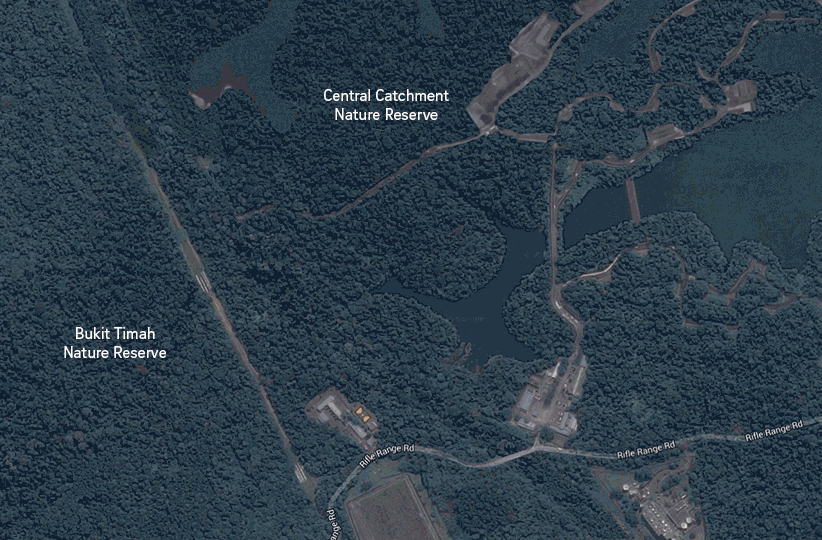
The eco-link, completed in 2013, restored a connection between the two nature reserves which had been separated since 1986. But for some nature lovers, it came a little late.
“In the early days, we waited for something to happen before we reacted, we never did anything until the bulldozer turned up on site. It was too late,” said Mr Subaraj, who currently chairs a biodiversity study for the Mandai heritage precinct.
He recalled how there was violent objection from a “tiny group” of conservationists when plans to build the BKE was announced in 1982.
The 11-km highway joins the Pan Island Expressway to Woodlands, and eases congestion to and from the Causeway. It saved motorists travelling to Woodlands 30 minutes, as it cut straight through the centre of Singapore to the north of the island.
But it also broke the connection between the Bukit Timah Nature Reserve and the Central Catchment Nature Reserve.



Conservationists warned then that the Bukit Timah Reserve, a primary forest, may not survive in the long term, cut off from its hinterland - the Central Catchment area, which includes MacRitchie, Upper and Lower Peirce, Seletar reservoirs and the Nee Soon Swamp Forest.
Those who voiced concerns included Dr Wee Yeow Chin, then honorary secretary of the Malayan Nature Society, and noted historian and cinematographer Ivan Polunin.
"In the past, there was a pipeline between which seemed to cut off the Bukit Timah reserve from the general catchment area. But in fact the flying lemur and other little animals could still cross. Now with a big, broad highway, it’s just not possible," Dr Polunin told The Straits Times in 1985.
But matters could have been worse.
Mr Wong Yew Kwan, who was the commissioner of Parks and Recreation from 1974 to 1982, was concerned when plans for the expressway were circulated by the then Public Works Department (PWD). He suggested that the road be shifted a little to save some valuable primary forest trees.
"As a naturalist, I know Bukit Timah is very valuable. They first proposed cutting far into Bukit Timah, so in the end I proposed to move it towards MacRitchie," Mr Wong, now 83, told The Straits Times. "They agreed to that, but still something was destroyed."
Would the plan to build BKE be approved today?
Both Mr Wong and Dr Tan felt that more consideration would have been given to preserving the forests.
Dr Tan, now CEO of Gardens by the Bay, said: “I think it would be more difficult, as public sensitivities regarding our natural heritage has gained maturity.”
Do the animals really need a bridge?
Conservationists were concerned not just about the impact of the BKE, but the encroachment of quarries on the fringes of the Bukit Timah reserve, stress from visitors, and in the 1990s, condominium developments that abutted Bukit Timah reserve.
All were likely contributing factors to the degradation of the reserve then.
Mr Subaraj said he witnessed the reserve become a forest island surrounded by concrete jungle. “With the creation of the BKE, you take away all the forest that was once on the highway... so winds come in during stormy days and started knocking down trees on Bukit Timah Hill,” he pointed out.
“I watched the trees come tumbling down, I watched the forest dry up, I watched certain animals almost go extinct because they are used to the moist rainforest and now we have a dry forest.”
Animals such as the large forest gecko and cream-coloured giant squirrel have not been sighted in Bukit Timah since the early to mid-1990s.
Measures have since been taken to mitigate these effects.
A major change was the addition of two parcels of land to the reserve, expanding it from 80ha to 163ha. This minimised the winds and reduced the drying effect.
And then, there’s the eco-link.
Without a safe link for animals to travel between the two nature reserves, plant and animal species with already small populations would be cut adrift from their kind on the other side of the expressway.
Can animals find the link?
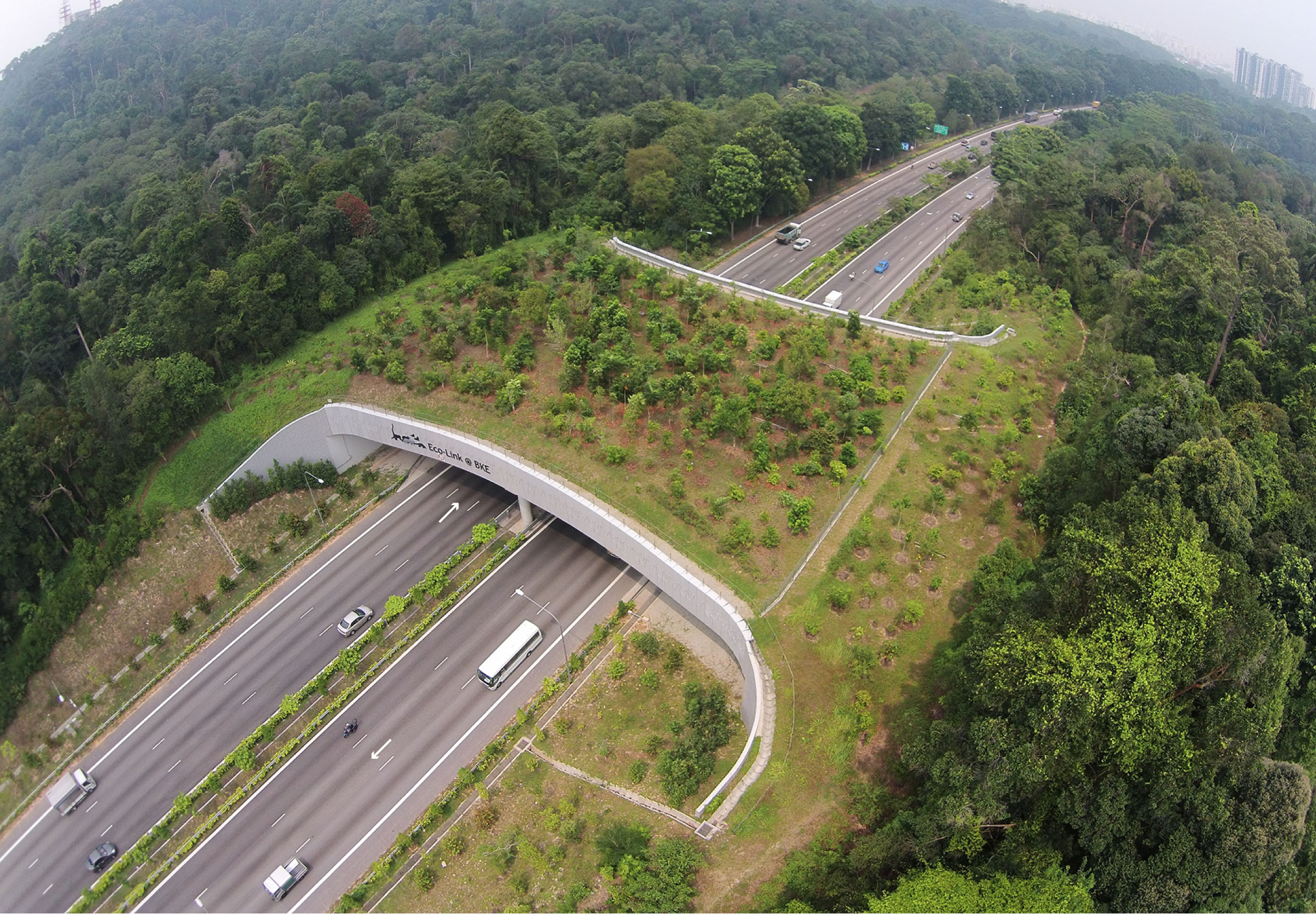
BUKIT TIMAH
NATURE RESEVE
(BTNR)
TO
WOODLANDS
TO PIE
(CITY)
CENTRAL CATCHMENT
NATURE RESERVE
There are no signs, and no, the animals don’t read maps. But somehow, they have found their way to a 50m-wide bridge in the centre of a 2,000ha reserve.
"A lot of people were very sceptical - there is a whole long stretch of BKE, will the animals be able to find it?" said Ms Sharon Chan, who oversees the team managing the eco-link project.
Ms Chan, deputy director at NParks, said the team was extremely excited when camera traps captured footage of pangolins and palm civets using the link to cross between the Bukit Timah and Central Catchment nature reserves in October 2014.
A lot of people were very sceptical - there is a whole long stretch of BKE, will the animals be able to find it?Ms Sharon Chan, Deputy Director at the National Parks Board (NParks)
Take the common palm civet, also called the musang or toddy cat, which is known for its odorous scent and taste for palm sap. More than one has been captured on cameras crossing the link every month, Ms Chan said.

Common palm civet
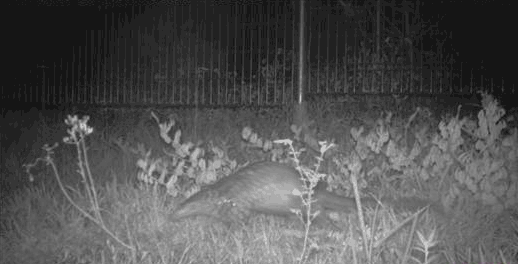
Pangolin
It is not classified as endangered, but still a rare sight here.
"I was based in Bukit Timah (Nature Reserve) in the 1990s, and I would only get a whiff of it... I had a hard time looking for them," she told The Straits Times.
The solitary animals are territorial. When food gets scarce, they are less able to co-exist in close quarters.
Previously, when they tried to move out of the nature reserve, “it’s road road road road road, noise noise noise noise noise – they have a hard time finding their way out", Ms Chan said.
Having the civets cross from reserve to reserve is also good for the plants, as they excrete the seeds from the fruit they eat, and help to disperse them - enhancing plant biodiversity.
It’s not just the land mammals, but quite a few varieties of birds who needed help. Species like the emerald dove and the striped tit-babbler do not fly long distances, and prefer to hop from shrub to shrub.
Besides food, the birds also seek cover to hide from predators. The emerald dove, for instance, tends to hide away in the undergrowth at the slightest sign of danger.
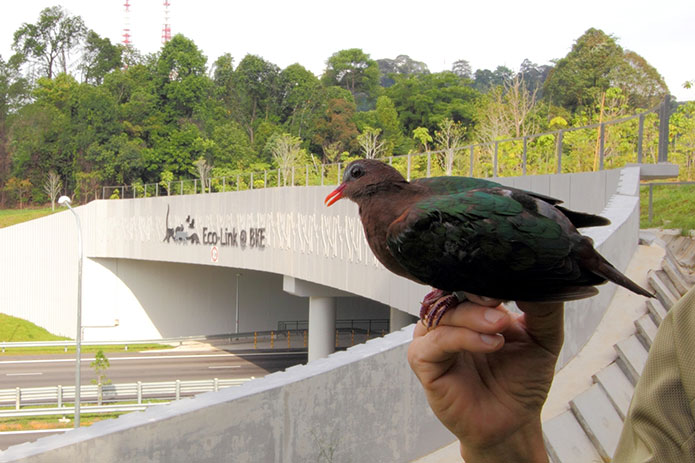
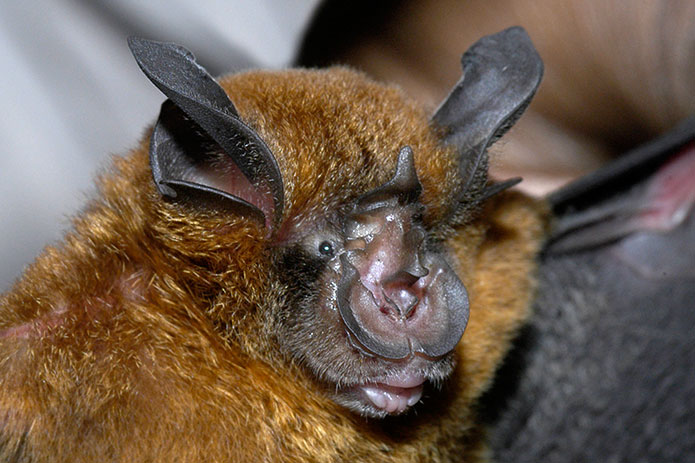
It has been spotted using the link as the vegetation matured into medium-sized shrubs and small trees.
Using bat detectors capable of picking up the ultrasonic bat calls, one study has found that bats are also regular users of the eco-link.
At least one species, the glossy horseshoe bat, would not be able to cross the link without help.
The tiny bat, just 4g to 8g in weight, is adapted to fly through undergrowth that protects it from the elements.
"Because of the vegetation – it’s more complex, there are more insects, which draws in the bats," said researcher Benjamin Lee, a PhD student at the Durrell Institute of Conservation and Ecology at the University of Kent.
So while no one knows how exactly the animals find the link, it seems that some combination of factors in the design of the bridge draw them to it and off the roads.
'Guessing' what the animals want
The problem with designing a bridge for animals is that you can’t ask them what they would like. But through observing the animals, and their understanding of the local ecology, the team at NParks set out to build one that the wildlife here would use.
Wildlife crossings are now common in Europe, Canada and the US, but the Eco-Link@BKE is the first purpose-built bridge for wildlife in South-east Asia, and possibly Asia.
Before work started, the team at NParks went to Switzerland and the Netherlands, which have built hundreds of wildlife crossings.
Eco-links in other countries
From that study trip, they determined that the minimum width of the bridge should be 50m for the animals to “feel comfortable” on it. The hour-glass shape was also designed to encourage wildlife crossings.
But the European crossings were built for a temperate climate.
Singapore’s eco-link had to be adapted to an equatorial climate, tropical foliage and the very different animals that evolved in this environment.
Said Mr Wong Tuan Wah, NParks’ director of conservation: "We are a tropical country... so the vegetation there is very different... but the principles are the same worldwide - to reconnect two halves of a forested area."
After plans for the eco-link were announced in 2009, NParks embarked on surveys of the area, and put in camera traps before construction started to monitor the animals already in the area.
Said Ms Chan of NParks: “During construction, we also did a quick check to make sure it did not affect the animals. If not, we would end up with a bridge where no animals are there.”
In July 2011, construction of the link by Eng Lee Engineering began. The soil on the eco-link originates from the site - it was excavated and stored when construction began.
The depth of the soil on the link was also made deeper, to improve water retention, and ensure that tall trees can take root.
How the bridge works
VEGETATION
DRAINAGE
SOIL
BASE
The bridge is designed to support a full forest, with the soil layers of 2m being one of its unique features compared to other bridges around the world. Click on the information buttons to find out more.
For additional precautions, purpose built funnel fencing can be installed along the perimeter to ensure all targeted animals are guided towards the bridge. Principal landscape architect, Stephen Caffyn, also suggests installing specially designed escape ramps and hatches in case the animals get caught on the highway. So far, the vegetation has been enough to help guide the animals across the bridge.
The bridge is designed to support a full forest, with the soil layers of 2m being one of its unique features compared to other bridges around the world. Click on the information buttons to find out more.
For additional precautions, purpose built funnel fencing can be installed along the perimeter to ensure all targeted animals are guided towards the bridge. Principal landscape architect, Stephen Caffyn, also suggests installing specially designed escape ramps and hatches in case the animals get caught on the highway. So far, the vegetation has been enough to help guide the animals across the bridge.
The bridge is designed to support a full forest, with the soil layers of 2m being one of its unique features compared to other bridges around the world. Click on the information buttons to find out more.
For additional precautions, purpose built funnel fencing can be installed along the perimeter to ensure all targeted animals are guided towards the bridge. Principal landscape architect, Stephen Caffyn, also suggests installing specially designed escape ramps and hatches in case the animals get caught on the highway. So far, the vegetation has been enough to help guide the animals across the bridge.
After the eco-link was completed in 2013, native trees and shrubs were planted along the bridge to mimic the rainforest.
Plants along the edges of the link act as a buffer to screen noise and lights from the expressway below.
In the centre of the link, trees that can grow to 15m were planted. When mature, they will create a dense canopy that simulates a natural forest environment. The plants were also chosen to provide food for the animals, and draw them in.
No man’s land amid busy highway
When reporters visited the link on Nov 4, 2015, traffic bustled on each side of the link and helicopters whopped overhead, but within the heart of the eco-link, it was no man’s land.
Listen to the constant hum of sound that can be heard from the bridge. Despite the noise, animals haven't been deterred from using the eco-link.
No paths, no lights and most of the time, no humans allowed. On both ends of the link, “No Entry” signs are a warning to homo sapiens who may think to trespass.
The guided walks for the public are limited to a gravel path on the side of the link.
Dr Shawn Lum, president of the Nature Society (Singapore), said that there had been initial concerns about whether animals would really use the bridge, given the traffic noise and the exposed environment, but these did not come about.
"Wildlife is starting to come and the vegetation is starting to grow... So I’m delighted, and whatever initial concerns or worries that we had, luckily turned out not to have materialised," he said.
But like humans, there are some animals NParks wants to keep out of Bukit Timah Nature Reserve, specifically wild boar and Sambar deer.
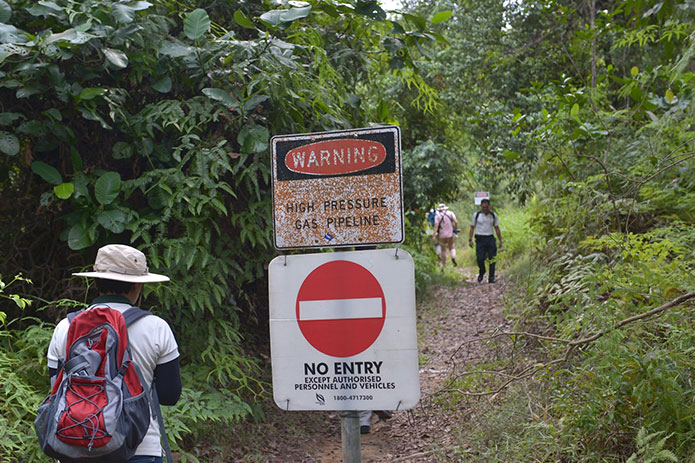
At one end of the eco-link lies a fence, with only a 30cm gap at the bottom, for smaller mammals like pangolins, squirrels and civets.
That is because boars and deer can damage the forest environment, and the smaller Bukit Timah Nature Reserve is not able to sustain the large mammals. Boars, in particular, like to dig the ground for worms, unearthing saplings and disrupting the forest floor.
The other reason they are kept out is to minimise chance encounters with humans.
Urbanised Singaporeans sometimes "freak out" when they come face to face with a wild animal, Ms Chan said.
"If they don’t know the animal, they don’t understand the animal and they will fear the animal, so that is why the outreach programme is very important," she said. "The guided walk is to tell people what we are doing, and about the animals. We want to remove the doubt, so they can help us protect them."
Bringing back the banded leaf monkey and flying lemur
One of the animals Singaporeans have had little chance to know is the banded leaf monkey, one of two types of monkeys native to Singapore. They are elusive, prefer to stay high up in the tree canopy, and, with an estimated 40 to 60 monkeys remaining in Singapore, rare.
Their more vivacious cousins, the long-tailed macaques, are more commonly sighted, and have been seen using the eco-link to cross the BKE. But they are so acclimatised to humans that they also use pedestrian overhead bridges to cross roads.
With the eco-link in place, Ms Chan of NParks hopes that the banded leaf monkey will one day make its way to Bukit Timah.
She also looks forward to spotting the Malayan colugo (flying lemur) and the red-cheeked flying squirrel on the eco-link when the trees grow tall enough to support them.
“These are all the future animals that we want to play matchmaker to. Otherwise some will only be on one side, and they can only look at one another,” Ms Chan quipped.
Besides the banded leaf monkey and Malayan colugo, another pool of animals that may need more help to cross the link are frogs.
These are all the future animals that we want to play matchmaker to. Otherwise some will only be on one side, and they can only look at one another.Ms Sharon Chan, Deputy Director at the National Parks Board (NParks)
As it is now, the eco-link is a little on the dry side for amphibians.
“They are reliant on streams, pools and moist areas. To abandon that and cross the eco-link is difficult for them,” said wildlife consultant Subaraj, who added that the link is still “a step in the right direction”.
For the frogs to hop on, areas with “ephemeral ponds or seeps” are needed, said Dr Lum of the Nature Society (Singapore).
But he too sees hope for the future.
He said: "Even if only a few species were to recolonise, stabilise, or increase in number in the Bukit Timah Nature Reserve, I would consider the eco-link a great success, as this would suggest that degradation of wildlife in an isolated Bukit Timah may have been arrested."
In fact, efforts to improve the link are ongoing. NParks is continually monitoring the area using camera traps, and data is collected and analysed regularly. Research studies are also being planned, or are in progress.

Banded leaf monkey
The banded leaf monkey’s range has been largely limited to the Nee Soon Swamp area in the Central Catchment Nature Reserve since 1987, when the last survivor in Bukit Timah met an untimely death.
The disappearance of the banded leaf monkey from Bukit Timah is a tale that has gained “folkloric proportions” in the nature community, said Dr Lum of the Nature Society (Singapore).
It is said that the lone elderly female primate came to the ground, and was mauled to death by a dog (some say a pack of dogs) from a nearby village.
Once common, the monkey has been rare in Singapore since the 1930s, and only one troop was left in Bukit Timah by the 1960s.
While the population in Bukit Timah reserve had been in decline before the BKE was built, the construction of the highway ensured that animals lost from the forest would likely not be able to re-colonise it, Dr Lum said.
In recent years, there has been anecdotal evidence that the monkeys are venturing out of Nee Soon Swamp. But they have yet to be seen in MacRitchie Reservoir where the link is located, said Ms Andie Ang, who studied the monkeys from 2008 to 2010 for her master's thesis. She is now a doctoral student at the University of Colorado Boulder in the United States.
As things stand, it may be a few more years before the link can be used by the banded leaf monkey. Being an arboreal species, they thrive in the tree tops, and rarely come to the ground.
The trees in the eco-link will need to grow much taller to form an “overpass” for the monkeys.
Having two populations of monkeys, in the Central Catchment area and in Bukit Timah, will be better than having one, said Dr Amrita Srivathsan, a biologist at the National University of Singapore. “Their chances of survival will increase,” said Dr Amrita, who has conducted genetic research on the monkeys.
But it will not restore the genetic pool of the troop of monkeys that went extinct in Bukit Timah. A study done by Ms Ang and Dr Amrita found that the remaining monkeys have very low genetic variability - a long-term concern that is difficult to address.
Said Ms Ang: “If they use the eco-link, there are potentially more food sources for the monkeys, but you need more monkeys to expand the gene pool.”
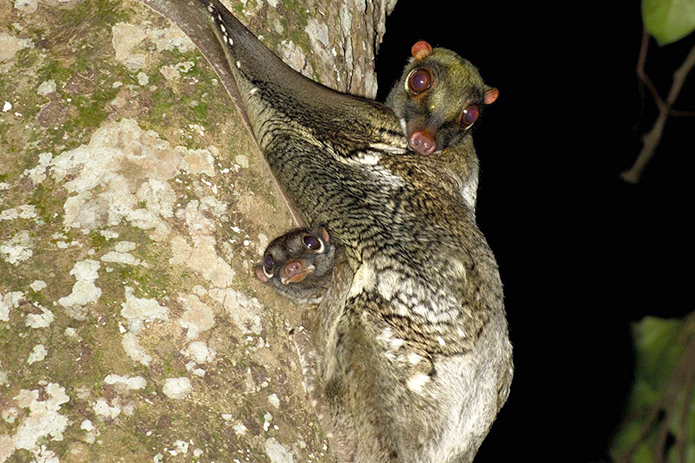
Malayan colugo
The Malayan colugo or flying lemur glides from tree to tree, and hardly ever sets foot on the ground.
The trees must reach a certain height, possibly 15m, before colugos can launch off them, Ms Chan said. Even when resting, the colugos perch on tree trunks, or hang upside down on branches.
Dr Norman Lim, who has published a book on the Malayan colugo, said: “They are gliders, they don’t come down to the ground, so there must be enough connecting routes for them to get from one place to another.”
While he has seen colugos gliding over roads like the Mandai Lake Road, they prefer dense canopy.
There are about 1,000 colugos in the wild here, which makes their situation less precarious than the banded leaf monkey’s. And unlike the monkeys, the link may help to enhance their genetic pool.
Said Dr Lim, a lecturer at the National Institute of Education: "With the habitats connected, two populations of colugos which were previously separated have the chance to interbreed."
More wildlife links to come?
Now that the link has proven popular with the animals, conservationists are setting their sights on more bridges for wildlife.
Some experts suggested introducing eco-links in the Mandai area, having small bridges to connect patches of forest within the Central Catchment area, and building a link between Bukit Batok Nature Park and Bukit Timah Nature Reserve.
Mr Tony O’Dempsey, a council member of the Nature Society (Singapore), said: "Since Bukit Timah Nature Reserve and Central Catchment Nature Reserve are now connected by the eco-link... if you hook up Bukit Batok Nature Park with Bukit Timah, then you extend the viable area for arboreal species like the monkey, slow loris and flying squirrels."
Ultimately, the hope is that more of such ecological crossings will connect the wooded areas in Singapore, said Mr Subaraj.
He added: "The hope is that there will be more eco-links that can not only provide a safe connection for wildlife, but also connect nature areas so that the genetic pool is interlinked."
Those who want to visit the Eco-Link@BKE must join a guided walk organised by the NParks.
The first eight tours until Jan 9 are now fully booked. Monthly tours are planned from March next year, but are limited to small groups.
To minimise disturbance to the animals, visitors can walk only on a gravel path at the side of the eco-link.
On the walks, which last about one-and-a-half hours, they can learn about the types of animals that cross the link, how it supports biodiversity, and the two nature reserves it connects.
Each session can take a maximum of 20 people.
Avoid wearing bright-coloured clothes, as these are often interpreted as danger by animals
Avoid using insect repellent or sunscreen, as the scent from these products may deter the animals from using the bridge
Wear a long-sleeved shirt and pants to avoid insect bites
Wear proper footwear such as hiking or covered shoes
Bring sufficient water and a hat to shield yourself from the sun
